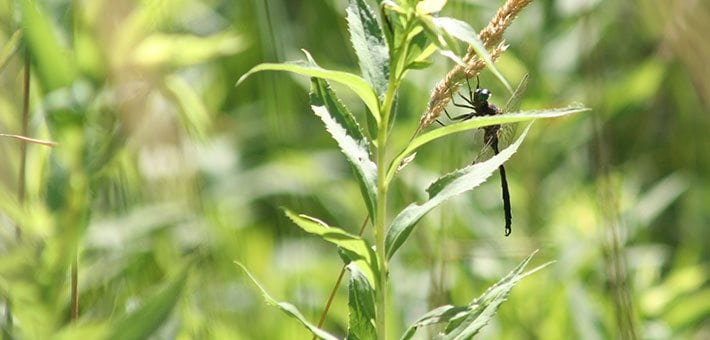
Imagine it’s midsummer and you are walking through a fen, surrounded by tall rushes, sedges, and reeds. A brilliant flash of green catches your eye before quickly disappearing. You follow the movement and turn just in time to see large, vibrant emerald eyes guiding a green and yellow striped body and a long, thin, brown abdomen. It’s a Hine’s Emerald (Somatochlora hineana). You’re lucky to have seen one! These dragonflies are listed as Endangered in both Canada and the United States, the only two countries where they can be found.
Dragonflies and other insects are often overlooked as endangered species in favor of larger, more charismatic species but they are suffering from many of the same threats as these larger animals. In the case of the Hine’s Emerald, that threat is habitat loss and degradation due to human activities and invasive species.
Hine’s Emeralds require very specific wetland habitat. They live in marshes and fens that occur on limestone bedrock and that are fed primarily by groundwater. Dragonflies have three life stages (egg, larva/nymph, and adult). For the Hine’s Emerald, all of these stages occur in these particular wetlands. Eggs are laid in shallow water or mud. Once the eggs hatch, the aquatic larvae live in the marsh and use crayfish burrows found in the mud as shelter. After 3-5 years, the larvae leave the water and the adults emerge from their larval casings to become the familiar dragonflies we know.
Hine’s Emeralds are only found in a handful of these wetlands in Ontario, Canada and in four states in the central United States. Many of these wetlands are facing threats from encroaching developments, contamination, and invasive plants that alter and degrade the habitat (COSEWIC 2011). Residential developments often require wetlands to be drained to accommodate for the building of new structures. This completely removes the wetland habitat Hine’s Emeralds require.
Other threats do not entirely remove habitat but rather alter it so that it is no longer suitable. Agricultural runoff, which is full of fertilizers and pesticides, can run into the groundwater. The wetlands used by Hine’s Emeralds are fed by this groundwater, leading to contamination of the habitat. Invasive plants, such as the European Common Reed, cause trouble by excluding native plants, removing bare mud substrate and, potentially, decreasing the number of crayfish burrows. This decreases the quality of habitat for the larvae of the Hine’s Emerald.
Maintaining the integrity of our wetlands is not just important for the species that live there. Wetlands perform many biologically important roles for ecosystems and economically important roles for humans (Barbier et al. 1997). For example, wetlands have been referred to as nature’s kidney due to their ability to filter water and transfer excess nutrients into the sediment and into plants. This improves water quality. Additionally, wetlands provide an important means of stormwater management by helping to prevent flooding.
Recent research efforts on the Hine’s Emerald have focused on learning more about the biology of these rare creatures. In particular, we don’t have a good estimate of the population size of these dragonflies. With such a localized distribution and secretive habits, it’s hard to get a good estimate of how many of these elusive Emeralds are left. This is important information if we want to maintain a healthy population! Researchers are using genetic techniques to estimate population sizes and sex ratios (Monroe & Britten 2015). This information can be used to monitor and help recover Hine’s Emerald populations.
Habitat loss and degradation is occurring all over the world from to large-scale destruction, such as the massive removal of tropical forests, to small-scale perturbations, such as the contamination of water in the marshes used by the Hine’s Emerald. Every little bit of habitat is important and you never know what unique species may be relying on some natural space near you. Keep an eye out and maybe you’ll even catch a glimpse of the brilliant green eyes that give the Emerald dragonflies their name.









